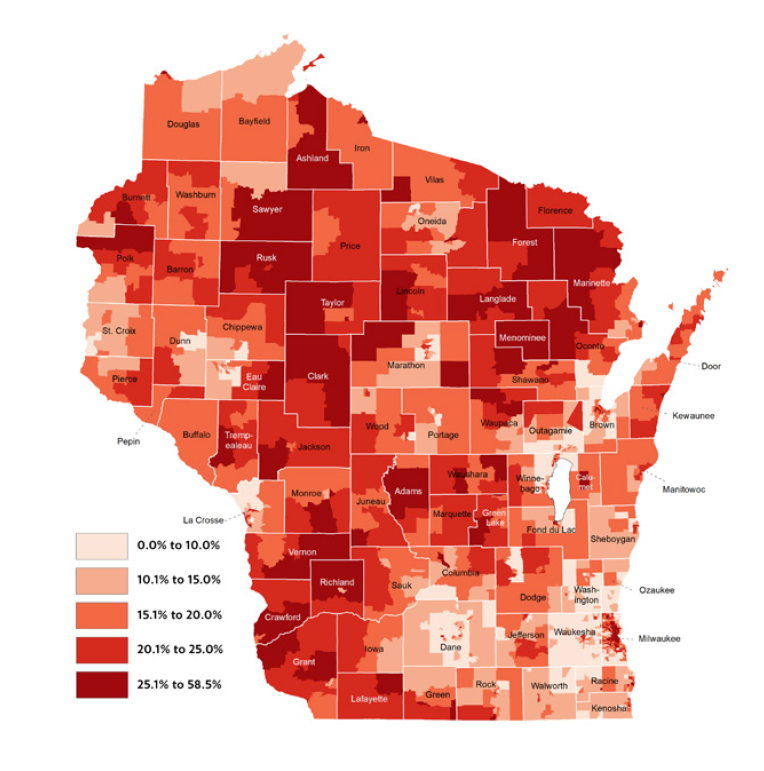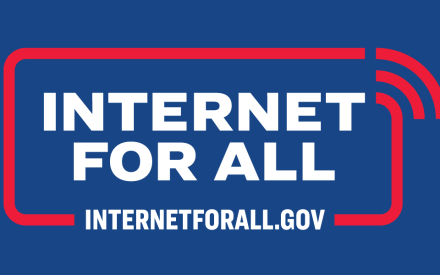Access to broadband is increasingly important, if not essential, to participation in modern life. Although many households may experience slow internet speed that compromises their ability to work, learn and recreate at home, there are many households in the U.S. and across Wisconsin that lack any access at all to the internet. In many regions of Wisconsin, more than one in four households do not have access to internet.
Internet can be delivered to a household through a variety of technologies. Some of these technologies are better-suited for high-speed service than others. Fiber, or fiber-optic, is currently viewed as the most preferred as it carries the greatest potential for transmitting large amounts of information (data). Technologies also vary in the accessibility. In general, faster internet technologies such as fiber also come with higher infrastructure costs, especially over rugged or complex terrain such as in much of rural WI or dense urban areas, making them more difficult to implement (CTC Technology and Engineering, 2014). In some such areas with challenging geography, other technologies such as wireless may be easier to use, even if offering a slower connection. Table 1 shows different types of broadband technology and their qualities.
TABLE 1: TYPES OF BROADBAND CONNECTIONS
Source: (1) Federal Communication Commission. “Types of Broadband Connections.” July, 23, 2014. Available at: https://www.fcc.gov/general/types-broadband-connections.
(2) “Broadband Reference Guide: A Digital Resource for Stakeholders.” Broadband & E-Commerce Education Center. University of Wisconsin Extension Madison. January, 2014.
In Wisconsin, households in rural areas are clearly more likely to go without internet (Map 1), meaning they lack access to internet in their home either because the technology is not available or they choose not to because of cost or personal preference. Many census tracts in northern Wisconsin have high shares of households without internet access including those found in Ashland, Sawyer, Rusk, Price, Florence, Forest and Marinette counties. Households in rural census tracts found throughout central and southwest Wisconsin are also much more likely to report a lack of internet access. While rural areas clearly have less internet access and density seems to be a key factor in explaining the disparity, it could be other features of rural areas as well. For example, rural areas can feature varying terrain conditions, and, importantly, lower incomes when compared to urban areas.
MAP 1: SHARE OF WISCONSIN HOUSEHOLDS WITHOUT INTERNET ACCESS BY CENSUS TRACT
 Income is an important aspect of broadband access—regardless of rurality, low-income households have less access to broadband. That means households in rural areas are not alone in their lack of internet access. Many census tracts in metro areas also show high shares of households without internet, such as census tracts in the urban cores of Milwaukee, Madison, Green Bay and Racine. While these urban areas likely have the physical infrastructure for access, the cost, especially in low-income areas, may be prohibitive. In developing policy to reduce the number of households without internet in a given area, it is important to understand the cause of low internet access. Areas that lack infrastructure but contain populations that would access internet if it was available may want to prioritize strategies and policies that encourage the development of physical resources needed to provide access. Conversely, more urban areas that have adequate broadband infrastructure, but still have a high proportion of households without internet may need to prioritize demand-side interventions, focusing on issues of affordability and expanding outreach and education so that residents are better able to take advantage of the benefits of broadband.
Income is an important aspect of broadband access—regardless of rurality, low-income households have less access to broadband. That means households in rural areas are not alone in their lack of internet access. Many census tracts in metro areas also show high shares of households without internet, such as census tracts in the urban cores of Milwaukee, Madison, Green Bay and Racine. While these urban areas likely have the physical infrastructure for access, the cost, especially in low-income areas, may be prohibitive. In developing policy to reduce the number of households without internet in a given area, it is important to understand the cause of low internet access. Areas that lack infrastructure but contain populations that would access internet if it was available may want to prioritize strategies and policies that encourage the development of physical resources needed to provide access. Conversely, more urban areas that have adequate broadband infrastructure, but still have a high proportion of households without internet may need to prioritize demand-side interventions, focusing on issues of affordability and expanding outreach and education so that residents are better able to take advantage of the benefits of broadband.
This work was supported by a grant from the United States Department of Commerce Economic Development Administration in support of Economic Development Authority University Center. Any opinions, findings, conclusions or recommendations expressed in this material are those of the authors and do not necessarily reflect the views of the U.S. Department of Commerce Economic Development Administration.














